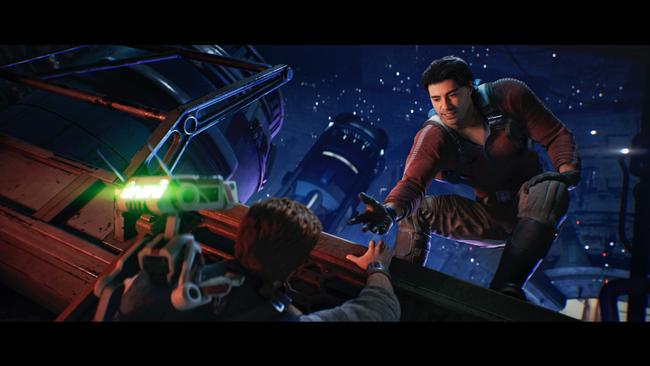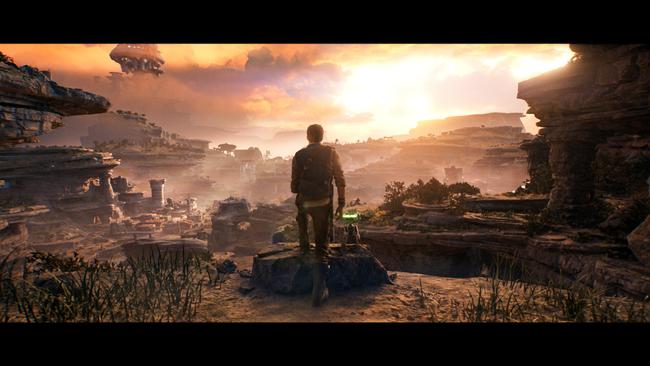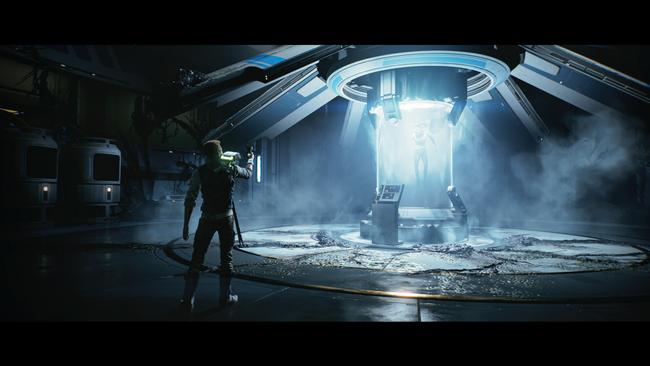
Star Wars Jedi: Survivor Review
There's a built-in benefit to sequels; when you're developing the first entry in the series, you do so in a relative vacuum, but when it comes time for a successful game to become a proper franchise that's when developers get the chance to address any of the misgivings with the original game; whether that comes down to the story, the level design or other aspects of the gameplay. The best sequels can take what was already a strong foundation and bring things to the next level; much like Respawn Entertainment has managed with Star Wars Jedi: Survivor.
When I had played the previous entry in the series - Star Wars Jedi: Fallen Order - I ultimately walked away from it happy with what I'd played, but with few key complaints with the game as a whole. The combat, while certainly not bad, left a lot to be desire - it felt overly basic, while at the same time feeling clunky. Much the same could be said about the game's platforming mechanics, but to an even greater degree - while I'd liked the idea of the challenges, it never quite felt like I was fully in control during these sections at the best of times, and it felt like I was actively fighting against the controls at its worst. The story, while definitely not bad, left a lot to be desired - especially with the rather basic characterization of the game's main and supporting cast of characters.

Put another way - there was plenty of room for Jedi: Survivor to grow, and grow it has. Not only has main character Cal Kestis received an external makeover; he's been beaten down over the years of fighting a losing war with the Galactic Empire. At the start of the game's journey, Cal is perhaps at his lowest yet; and it's only the discovery of a hidden, mythical planet in Tanalorr - specifically, the promise of an untouched planet where he and others hoping to resist the empire could hide themselves away from prying eyes - that pushes him forward, despite how the odds have been stacked against him.
It's, perhaps, a basic premise; at least at the start. What's far more important are the characters; and how both others have changed in the years since the events of the first game, as well as some of the new faces you might find in both the main story and sidequests alike. Fittingly, much of the game takes place on Koboh - a massive planet, far larger than any of the zones from the first game. While there are of course other planets you can and will explore through the story, it's fair to say that players will be spending the majority of their time in Jedi: Survivor on Koboh, exploring its secrets and getting to know the characters that have drifted their way onto this backwater planet, and made it their home.

Pyloon's Saloon is Greez Dritus' current home and establishment, and all manner of folk will become regulars to the establishment over time, and the cantina itself will grow ever more lively the more you manage to wrangle into visiting. Many of these side characters themselves are tied to game-spanning sidequest chains, or simply a cosmetic upgrade that you can make to the cantina itself. You can find out information about bounty hunters - optional boss fights - that after a certain point will dot the game's various maps. Defeating them and stealing back your bounty can be spent to buy upgrades to items such as Cal's new blaster. Any seeds that you find throughout the world can be planted on the cantina's roof, and the gentle giant gardener you might find along the way is more than happy to give you the juicy details about the plants you've grown to size.
There are all manner of other sidequests you can engage with, but it never feels like bloat just for the sake of it; if you're not interested in the gameplay or cosmetic benefits of the exchange, slowly getting to learn more and more about the inhabitants of the cantina - where they came from, how they ended up on Koboh, their proudest moments and sourest regrets - all go a long way to make Cal's world feel that much more alive. It wasn't something I thought was really missing from Fallen Order, but having played through Survivor it's hard to shake the feeling that I wouldn't have cared as much about the game's world if I hadn't taken the time to get to know the characters that graced it. Star Wars has always been at its best when it focused on the characters that lived under oppression, and Jedi: Survivor succeeds at embodying this dynamic with flying colors.

Speaking of the world - Star Wars Jedi: Survivor is a proper, current-generation release, and at least on the setup I had the chance to play it on, it absolutely shows. Fine world detail - lighting, texture work, geometry and the like - are all incredible when given the best opportunity to view it. The game's maps have been designed with the clear purpose of showcasing the utterly absurd draw distances that the game is playing with; when you turn a corner and peek out over a mountain, not only can you see all of these landmarks you've already visited - and the pillars denoting your meditation spots, too - there's something to be said for how the game absolutely sells its sense of scope and scale.
All of this work would've been spoiled if what was my main fault with the first game, the platforming, hadn't been retooled. Thankfully, not only is the responsiveness and overall feel of platforming significantly improved from the start - but every additional ability players gain access to on top of what was already present at the end of Cal's last journey increasingly makes the act of moving across the game's a world a far more fluid motion.
On a similar note, both the game's puzzles and enemy design have been improved; there's far more variety in both the category of puzzles you'll face, and the game manages to explore each of its ideas to what feels like a logical conclusion without overstaying its welcome. The variety of enemies you'll face throughout the game is a night and day difference versus how many you faced in Fallen Order; and as a bonus, any of the enemies that you have defeated and scanned with BD-1 can then be used in a fun minigame called Holotactics; where you can pit simulations of enemies against an NPCs own roster of enemies, considering which units might be a good counter to whichever they've chosen.

Combat, too, has been heavily expanded. Not only has Cal's number of stances grown from 2 to 5 (though you'll only ever be able to choose 2 you wish to use at any given time), but each of the stances themselves have far more going for them compared to the fare from the first game. Cal's new Blaster Stance was a favorite of my playthrough; especially once you upgrade the stance to allow you to charge your shots, and particularly if you opt to pair it with the Perk that increases your blaster damage. The new Crossguard stance is similarly fun; though the polar opposite of Blaster. Instead of fast-paced movement with an emphasis on ranged combat, it's all about slow yet powerful swings that are sure to take a chunk out of an enemy's HP - as long as you can get your attacks to connect.
Found all across the game world as either a reward for completing Meditation Chamber puzzle rooms, discovering them in hidden chests, completing sidequests or purchasing them from specific NPCs with collectables and so on; perks offer a way of buffing specific aspects of Cal's stats. You can make it so that you can be granted an additional Stim pack, or bolster your block gauge; in my case, I opted to buff my damage output when using blasters, upon switching stances, and after using a force attack. There are 25 different perks to discover and use, and offers yet another reason to engage with the game's side content.
Unfortunately, despite all this praise I can't in good conscience fully recommend the game without at least acknowledging some of the grievous technical issues I ran into during the process of my review; while the game does precompile shaders on PC, and it appears to have gone a long way for preventing stuttering throughout much of the game, there's a very unfortunate exception; Koboh, and Pyloon's Saloon itself. In other words, the one area you're going to spend most of your time in the game traversing. The area in Koboh around Pyloon's Saloon is incredibly CPU heavy; even at 4K max settings, which the game defaulted to on my PC setup, I would end up seeing my GPU usage drop as low as 70% during these CPU-bound scenarios.

I would on occasion drop below 60 FPS; and that's with a Ryzen 7 7700x, a CPU that AMD - at least as of the time of this review - is currently offering a free key for this very game with new purchases. While we did not have access to the console versions to test, everything that I've heard about the state of them is that performance mode is most likely not worth using; the sacrifices to resolution appear far too great going by the numbers I've heard spinning around, and you won't be hitting a locked 60 FPS anyway - I shudder to think about the state of the game on Xbox Series S.
By and large the experience I had with the game on my system was acceptable, outside of the stuttering near Pyloon's; but I'm well aware that although I didn't run up against a CPU bottleneck elsewhere in the game, I was also running a system significantly stronger than what I imagine most players would be playing the game on for themselves. If even I could see the warning signs - and from what I've been hearing, it's not like Intel CPUs are handling matters any better - it makes me worry how the game might feel to play on anyone that isn't using a CPU less than a year old. At least my own experience shows that you can get to the point where the hardware is up to the task for Respawn's vision; but unless you're willing to turn down a few settings and cap the framerate at 30FPS, it's hard to see any other way to get consistent performance on a system running the game's own recommend specifications.
It's hard to gauge how much of these technical hurdles are down to a rushed launch, poor optimization or simply the results of a game that hasn't been designed to run on last generation's hardware - but it takes what is undeniably a game of the year contender for me, and makes it difficult to fully recommend to anyone without either the hardware to back it up. Star Wars Jedi: Survivor is an excellent game, and an especially fantastic sequel; it's just a shame that most players will ultimately have to compromise when they decide where and how to play the game.